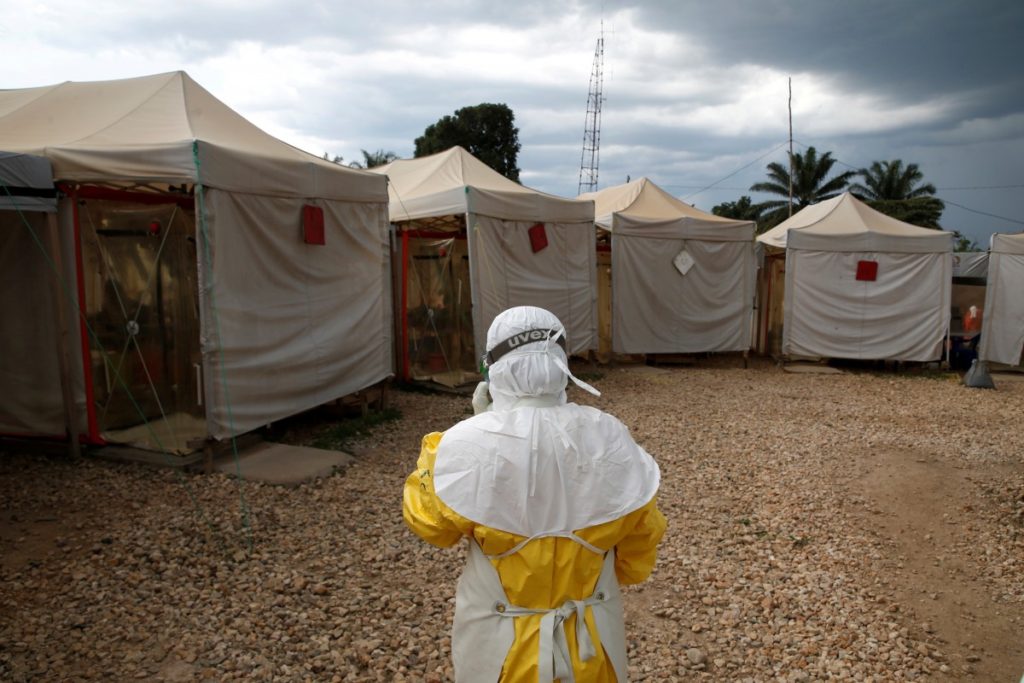
Health worker wearing Ebola protective gear in the Democratic Republic of the Congo.
Picture courtesy of The South China Morning News
The Democratic Republic of the Congo (D.R.C.) has been combatting an outbreak of the Ebola virus since August 2018. The death toll has continued to rise rapidly, and in September of 2019, more than a year after the outbreak commenced, there were a total of 3,188 cases and 2,129 deaths from the virus, making this the second largest Ebola outbreak on record.
The World Health Organization (WHO) and other similar groups have been working diligently to provide resources and staff to help combat this epidemic, but there have been countless challenges. There is also widespread fear that the virus will spread outside of the D.R.C.’s border into neighboring countries such as Uganda, Rwanda, and Tanzania, which poses a risk to the international community, particularly in Central Africa.
While trying to contain the outbreak, health workers and Ebola treatment centers have been the centers of targeted attacks, which have reduced the capacity for the D.R.C. and the international health community to effectively control the virus. From August 2018 to January 2019, there were 42 attacks directed at health facilities, and 85 health workers injured or wounded. These active threats to safety pushed some international aid organizations such as Doctors Without Borders to stop working in the affected communities and close their Ebola treatment centers. People living in the D.R.C. are very skeptical of seeking treatment at hospitals for Ebola because hospitals are associated with poor outcomes such as death, and the attacks further deterred people from seeking treatment once they started showing symptoms of the virus out of fear that they too would be attacked or physically harmed.
Map of Central Africa with a blue circle around major areas affected or at risk of being infected by the Ebola outbreak.
Photo courtesy of Gifex
The outbreak has largely remained within the borders of the D.R.C., but several cases have spread into the neighboring country of Uganda. On September 5, 2018, the major Congolese trading city of Butembo, a city with major connections to Uganda, recorded its first death from Ebola. In order to take precautions, Uganda commenced an Ebola vaccination initiative for its health workers in November 2018, and several months later in June 2019, Uganda confirmed its first official case of Ebola. The case was a five year old child from the D.R.C. who had been travelling with family members to Uganda from an area currently impacted by the outbreak; two of the child’s family members also contracted the virus and died in Uganda shortly after. Clearly the virus poses a threat to neighboring nations, so it’s surprising that more cases have not crossed international borders. This is largely thanks to emergency preparedness measures put in place by countries that share a border with the D.R.C.
I had the privilege of attending a United Nations General Assembly side event recently that was entitled “A World At Risk: Accelerating Global Preparedness for Health Emergencies.” At this panel, the Minister of Health of Uganda, H. E. Dr. Jane Aceng, discussed how her country has taken action to prepare itself for the possible spread of the Ebola virus across its border with the Democratic Republic of the Congo. Dr. Aceng noted that “an outbreak somewhere can be an outbreak anywhere,” so her country has developed a national action plan for health security that will help protect it from the threat of Ebola. Dr. Aceng went on to describe how the “porous border” between the D.R.C. and Uganda could be a major issue, but it is not catastrophically impacting Uganda because of the preparedness measures the country took after the Ebola outbreak in West Africa in 2014. The measures were undertaken using loans from the World Bank and through increasing national funding for research programs, laboratories, and health surveillance programs in order to better monitor the spread of disease in Uganda.
Photo courtesy of The Conversation
In July 2019, a man died from the Ebola virus in Goma, a city near the border of Rwanda that has a population of nearly 2 million people and is a major travel hub, which prompted the WHO to declare this Ebola outbreak a “public health emergency of international concern.” This declaration pushes neighboring countries to increase preparedness measures to help combat the spread of the virus, and it also brings more international attention to the epidemic.
Two notable international organizations, the World Health Organization and Doctors Without Borders, are currently in the midst of a disagreement about how best to combat the virus. Vaccines and antiviral drugs are being distributed to the communities at risk, but the international groups disagree on the best implementation and distribution methods. Furthermore, there are unofficial reports that the virus may have spread to Tanzania, but the Tanzanian government claims that this is untrue; the WHO has not corroborated these claims as of October 2019.
Overall, this outbreak of the Ebola virus in the Democratic Republic of Congo is certainly cause for international concern due to the potential for the virus to cross the Congolese borders into neighbouring countries. There are also internal (militia attacks) and external (international health organisations) conflicts that are making the containment of the epidemic more difficult. Only time will tell how the international community will continue to respond to this health crisis that threatens the stability and wellbeing of Central Africa.
Cassi Niedziela
